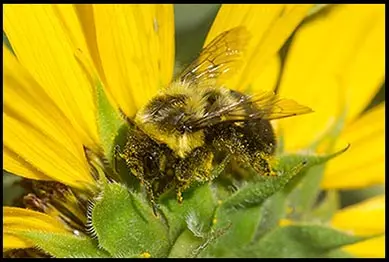In the United States, honey bees alone pollinate 80 percent of all flowering plants, including more than 130 types of fruits and vegetables.
How does this small creature accomplish so much for so many?
The honey bee’s body has multiple evolution-defying features, allowing it to provide food for its own family and produce enough extra for all of us to enjoy.
Honey: The Perfect Sweet
Female honey bees, also known as worker bees, have a special stomach, separate from their digestive stomach, to store nectar from flowering plants. When a forager bee returns to the hive, she regurgitates the nectar into the mouth of another worker bee, and that bee regurgitates into yet another bee’s mouth. This sharing process repeats itself from 10 to 20 times. Each time, enzymes in the bees’ stomachs break down the complex nectar sugars into simple ones, such as glucose and fructose, which are more suitable for long-term storage. The bees flap their wings to reduce the water content from about 80% in the nectar to less than 20% in honey.
Bees Wax
The honey bee needs a place to store its precious honey. In God’s creative way, He designed the female honey bee with eight unique glands on its abdomen that secrete a waxy substance, which bees collect with their legs and bring to their mouths. They chew the wax scales to soften them and mold them into honeycomb. These hexagonally arranged cells are perfectly shaped to store honey efficiently and also provide space for raising the queen bee’s larvae.
Producing wax is energy intensive: it takes about eight pounds of honey to produce one pound of wax. Honey bees meticulously reuse and recycle the existing wax within the hive whenever possible.
Pollen, the Superfood
Pollen provides proteins, fats, vitamins, and minerals necessary for the honey bees’ growth and development. While nectar provides them with quick carbohydrates for energy, pollen sustains their health and strength.
Honey bees collect pollen using specialized structures on their bodies and legs. When a bee lands on a flower, it brushes against its anthers (the part of the flower that produces pollen). Electrostatic forces cause the pollen grains to stick to the bee’s body, especially its hairy legs and body. After visiting a few flowers, the bee uses its legs to groom the pollen from its body. It gathers the pollen into structures on its hind legs called pollen baskets or corbiculae. The bee moistens the pollen with some nectar or saliva to make it sticky and form it into compact pellets.
Once her pollen baskets are full, the bee flies back to the hive. A single bee can carry up to half her body weight in pollen before returning to the hive. Upon her return home, she deposits the pollen into open honeycomb cells. Other worker bees pack the pollen tightly into the cell, sometimes adding a drop of honey to it. This mixture, known as bee bread, ferments slightly and becomes a nutritious food source for the colony, particularly for developing larvae.
Royal Jelly for a Queen
Honey bees produce royal jelly through glands located at the tops of young worker bees’ heads. This jelly is then fed to larvae chosen to develop into the specialized queen bees. This exclusive diet triggers biological changes that allow a larva to develop into an egglaying queen rather than a typical worker bee.
The Waggle Dance
Honey bees use specialized movements, like a kind of dance, to communicate precise directions to new food sources for the other bees in the hive. These “waggles” provide information including the direction and distance from the hive relative to the sun’s position. The dance involves a sophisticated use of angles, distances, and solar orientation that some argue is too complex to arise through incremental mutations alone.
In Summary
- Without the honey bee’s unique stomach enzymes and cooperative process, there would be no honey.
- Without specialized glands on the bee’s abdomen, there would be no beeswax to make the honeycomb where honey is stored.
- Without royal jelly from a gland in the bee’s head, there would be no queen bees.
- Without pollen baskets on their legs and an electrical charge on their fur, how would a honey bee collect pollen for the hive?
- Without the bees doing the “waggle dance,” how would they tell other bees where to find food?
Without any of these critical functions, there would be no honey bees to pollinate the plants of the fruits, nuts, and vegetables we eat.
While evolutionary biologists offer explanations involving gradual adaptations to environmental pressures, supporters of special creation argue that the honey bee’s unique body features, complex social structure, and critical ecological role seem precisely aligned to point to a purpose-driven origin. This perspective views honey bees’ existence as evidence of design rather than the result of random mutations and natural selection.
More information about the honey bee and more can be found in the book, “Our Incredible Created World” by Buddy Petty and Ed Landry







Mr. Petty writes a wonderful summary about the honey bee and explains the five key features that make worker bees such a unique creation. They are such a key link in our entire food chain that upon learning about these details, Darwin himself was confounded, realizing his theory could not account for just how they accomplished so much. Petty and Landry’s book, “Our Incredible Created World” includes similar summary’s about 50 different animals, but the honey bee article, is the longest at 4 pages, since they really are so incredible.